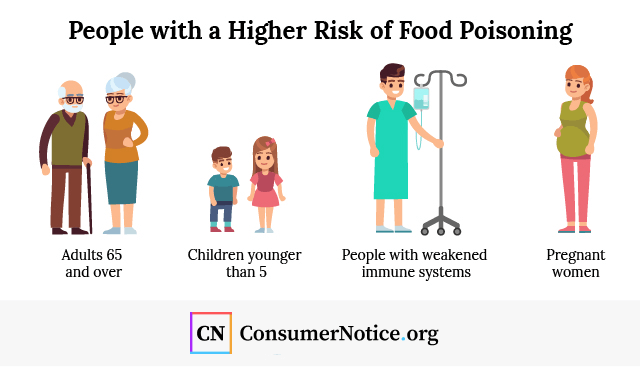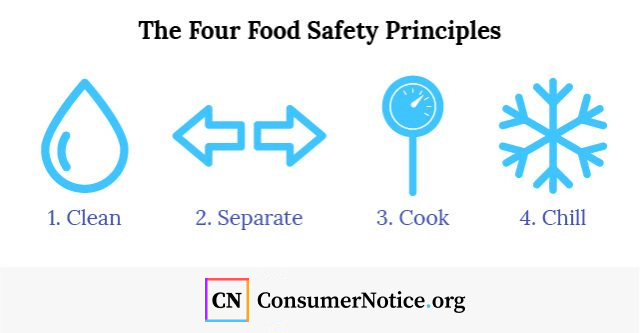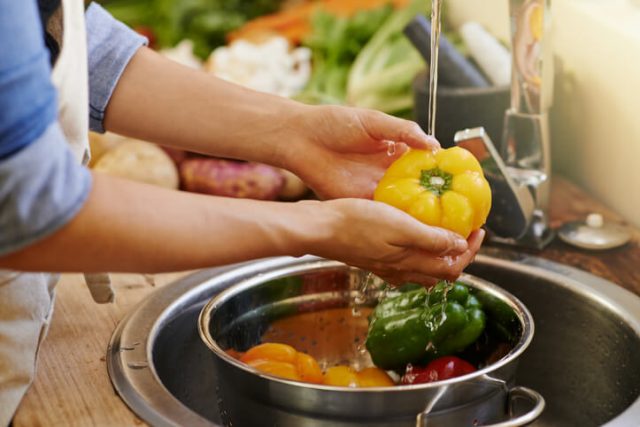Food Safety Guide
Following good food safety guidelines can prevent the spread of foodborne diseases, a leading cause of illness and death in the U.S. How you store, prepare and cook food can eliminate some of the most serious risks of foodborne illnesses or food poisoning.
About 1 in every 6 Americans will come down with a foodborne disease in any given year, according to the Centers for Disease Control and Prevention.
There are an estimated 48 million cases of foodborne illnesses in the United States every year according to the CDC. Those cases result in more than 128,000 annual hospitalizations and 3,000 deaths.
Bacteria and viruses are the most common causes of food poisoning, which includes any illness or disease you may get from eating contaminated food. Food safety practices in the home address ways to stop or destroy these threats before you sit down at the table.

What Foods Are Most Likely To Cause Food Poisoning?
You can get food poisoning from any type of food. The CDC estimates that leafy vegetables cause more foodborne illnesses than any other type of food — about 22 percent of all cases. But poultry-related foodborne illnesses cause the most deaths — 19 percent. Dairy products rank second for both illnesses and deaths — about 14 and 10 percent respectively.
| Produce | 45.9 |
| Dairy | 13.8 |
| Meat | 12.2 |
| Poultry | 9.8 |
| Seafood | 6.1 |
| Eggs | 6 |
| Grains and Beans | 4.5 |
| Undetermined | 1.1 |
| Oils and Sugars | 0.7 |

Food Poisoning Symptoms
Food poisoning symptoms can vary depending on the type of foodborne disease. Most people who get a foodborne illness will recover without medical treatment. But people who experience serious symptoms need to seek help immediately.
Five Serious Food Poisoning Symptoms Requiring Immediate Medical Attention
- Bloody diarrhea
- Diarrhea lasting more than three days
- Dehydration
- Fever higher than 102 degrees
- Frequent vomiting
Food poisoning symptoms can show up in as little as 20 minutes for some germs or may take as long as 4 weeks for others.
People with Higher Risks of Food Poisoning
Certain people are at higher risk of food poisoning based on their age and medical conditions.
Foodborne illnesses can be more serious or even fatal for pregnant women, young children, older adults and people with compromised immune systems.

These people should only eat meat, poultry and seafood cooked to the minimum safe internal temperature. They should avoid raw sprouts that can carry harmful bacteria and pay special attention to safe food storage and preparation rules. People at higher risk should also reheat deli meats to kill Listeria.

The Four Food Safety Principles – Clean, Separate, Cook & Chill
There are four food safety practices to prevent foodborne illnesses or food poisoning: clean, separate, cook and chill. These four steps are part of Fight BAC!, a nonprofit consumer-oriented food safety campaign.
These four food safety steps work together to protect food from contamination and to destroy harmful contaminants.

Clean
Bacteria and viruses can spread through your kitchen and onto countertops, cutting boards and utensils. Anytime you touch any of these items, you risk getting them on your hands and moving them into your food. This is called cross-contamination.
It’s important to wash your hands with soap frequently when handling food. You should wash before handling food and utensils, after handling foods like raw chicken or meat and after touching any surface or used dish. You should also wash your hands after coughing, sneezing or touching your face, hair or clothing.

You should thoroughly rinse all fruits and vegetables. Rinse them under running water immediately before preparing them. Use a produce brush under running water to scrub firm produce such as cucumbers or carrots.
Wipe up spills as soon as they happen and frequently clean any surface that comes in contact with food. Clean both the inside and outside of appliances, paying special attention to knobs, handles and buttons where hand contact can allow cross-contamination.
Separate
Separating foods as you prepare them will prevent contamination that may be in raw foods from getting in food that is ready to eat.
This step begins in the grocery store. Put your raw meat, poultry and seafood in separate plastic bags while shopping to keep potential contaminants from reaching other food in your cart or bag.
When you get home, store raw meat, poultry and seafood below ready-to-eat food in your refrigerator. This can prevent leaks from cross-contaminating your food.
When preparing food, use a clean cutting board for produce and a different one for raw meat, poultry or seafood. And never put cooked food on the same cutting board or plate used for raw food.
Cook
Cooking kills harmful microbes in meat, poultry, seafood and eggs. Each should be cooked to its individual safe minimum temperature.
Looks can be deceiving, but a food thermometer will ensure that your food is properly cooked and safe from harmful germs. Always measure near the center and in the thickest part of the food. Remember to clean food thermometers after use with hot, soapy water followed by a thorough rinsing.
Recommended Safe Minimum Temperatures
| FOOD | DEGREES FAHRENHEIT |
|---|---|
| GROUND MEAT | |
| Beef, pork, veal & lamb | 160 |
| Turkey & chicken | 165 |
| FRESH BEEF, PORK, VEAL, LAMB | |
| Steaks, roasts & chops | 145 |
| POULTRY | |
| All chicken, turkey, duck & goose parts | 165 |
| Whole chicken & turkey | 165 |
| Stuffing, cooked alone or in the bird | 165 |
| PORK & HAM | |
| Fresh pork | 160 |
| Fresh ham (raw) | 145 |
| Pre-cooked ham (for re-heating) | 140 |
| EGGS & EGG DISHES | |
| Eggs | Cook until both whites and yolks are firm |
| Egg dishes | 160 |
| FRESH SEAFOOD | |
| Fish | 145 (fish should be opaque and flake with a fork) |
| Shrimp, lobster & scallops | Cook until the shells reach their appropriate reddish colors
Lobster and shrimp should be opaque, or milky white, inside Scallops should also be opaque and firm |
| Shucked clams & shucked oysters | Cook until opaque and firm |
| Whole clams, mussels & oysters | Cook until their shells open; this indicates they are done Throw away any that don’t open |
| LEFTOVERS & CASSEROLES | |
| All leftovers & casseroles | 165 |
Chill
Foods are no longer safe to eat if they’ve been between 40 and 140 degrees for more than two hours. Keep refrigerated items below 40 degrees and frozen foods below zero degrees Fahrenheit.
Poultry, fish and ground meat should be cooked or frozen within two days. Other meats should be cooked within 3 to 5 days. Frozen foods can be kept for up to six months.
As soon as frozen foods get above 40 degrees, any bacteria in the food can start multiplying. You should thaw frozen foods inside the refrigerator, while in a pan to catch drips. Microwaves can safely thaw your food, too. You can also thaw food by putting it in a leak-proof bag and immersing it in cold water, but be sure to change the water every 30 minutes.

Other Food Safety Tips
You should also think about food safety when shopping, saving leftovers or dining out. There are clues to look for that can prevent you from buying or eating contaminated food. And there are steps you can take to keep from coming down with food poisoning from leftovers or an evening out.
Food Safety Tips When Shopping
Always check the expiration dates on food packages. The “sell by” date is how long the food can be on the shelf before it’s sold. The “use by” date tells you when it’s no longer safe to eat.
Make sure frozen foods feel frozen and refrigerated foods are cold when you buy them. Buy frozen or refrigerated food after your nonperishables. They need to be in your refrigerator within two hours of putting them into your cart. That time limit drops to one hour if the temperature is 90 or above.
Never buy food products with torn or damaged packaging or eggs that are unrefrigerated or cracked.
Avoid Risky Eating Behaviors
Raw and undercooked foods increase your risk of getting a foodborne illness.
The bacteria, viruses and parasites that cause food poisoning don’t change the look or smell of food. Your best protection is to freeze or properly cook foods to kill harmful pathogens.
Most Common Raw and Undercooked Foods Consumed in the U.S.
- Eggs – prepared with runny yolks
- Ground beef – undercooked hamburger
- Dairy – unpasteurized milk or cheese
- Seafood – raw oysters
Cooking foods to the minimum safe temperature and using only pasteurized milk and eggs when preparing foods can eliminate many risky eating behaviors.
If you choose to eat raw seafood, you can reduce your risk by choosing foods that were frozen. Freezing will kill parasites, but it doesn’t kill microbes.
Think About Food Safety When Dining Out
Several state and local health department websites publish restaurant health inspection scores for the public. Many also have their own apps that let you check a restaurant’s health score quickly. And the Yelp app started including health inspection information in a handful of cities starting in 2018 with plans to eventually include information on hundreds of thousands of restaurants across the U.S.
When you walk into a restaurant check to see that the table, floors and cutlery are clean. If they aren’t, the kitchen might not be clean either. Always send back food that arrives raw or undercooked.
If you take your leftovers, remember to put them in the fridge within two hours, just like with your groceries. And if those restaurant leftovers are still in your refrigerator after three or four days, throw them out.

E. coli, Salmonella & Other Food Poisoning Causes
Doctors and health authorities are unable to pin the cause of 80 percent of foodborne illnesses on an exact bacteria, virus, chemical or other substance. But about 20 percent of foodborne illnesses are caused by just 31 different pathogens. And most of those identified cases are due to just five.
Top Five Pathogens Contributing to Foodborne Illness in the U.S.
| PATHOGEN | ESTIMATED NUMBER OF ILLNESSES | PERCENTAGE OF PATHOGEN-RELATED ILLNESSES |
|---|---|---|
| Norovirus | 5,461,731 | 58 |
| Salmonella | 1,027,561 | 11 |
| Clostridium perfringens | 965,958 | 10 |
| Campylobacter spp. | 845,024 | 9 |
| Staphylococcus aureus | 241,148 | 3 |
Some germs don’t cause as many illnesses, but are more likely to lead to hospitalization. These include E. coli, Listeria, clostridium botulinum – which causes botulism – and vibrio.
Top Five Pathogens Contributing to Foodborne Illness Hospitalizations in the U.S.
| PATHOGEN | ESTIMATED NUMBER OF HOSPITALIZATIONS | PERCENTAGE OF PATHOGEN-RELATED HOSPITALIZATIONS |
|---|---|---|
| Salmonella | 19,336 | 35 |
| Norovirus | 14,663 | 26 |
| Campylobacter spp. | 8,463 | 15 |
| Toxoplasma gondii | 4,428 | 8 |
| E. coli (Escherichia coli) | 2,138 | 4 |
Recalls and Outbreaks
Food recalls happen if there is evidence that a particular food can make people sick. The food producer usually orders the recall when the farm or company discovers a problem. Problems can include discovery of viruses or bacteria, foreign objects like metal, glass or rubber in food products or allergens, such as peanuts or dairy, that are not listed on a food’s label.
Food recalls happen frequently in the U.S. Both the U.S. Food and Drug Administration and the U.S. Department of Agriculture regulate safety in the food supply. In some instances either or both agencies may also request a food recall if contamination turns food into a harmful product.
Foodborne outbreaks happen when two or more people come down with the same illness from the same contaminated food or drink or from the same food service operation such as a restaurant or food processing company.
When public health or regulatory authorities discover an outbreak, they move quickly to identify a cause and a source to prevent more people from getting the same illness.
-
2018
E. coli in romaine lettuce was blamed for five deaths, 96 hospitalizations, and 210 total illnesses in 36 states. The contamination was traced to chopped lettuce harvested in the Yuma, AZ area.
-
2015
Salmonella, tracked to Mexican cucumbers distributed by Andrew & Williamson Fresh Produce, sickened 907 people and killed six across 40 states.
-
2015
An E. coli outbreak at several Chipotle Mexican Grill restaurants sickened 55 people in 11 states. There were no deaths, but 21 people were hospitalized.
-
2013
An E. coli outbreak at Federico’s Mexican Restaurant in Litchfield Park, AZ sickened 94 people. Health investigators believed the illnesses were due to contaminated lettuce.
-
2011
A seven-month-long Salmonella outbreak from Cargill ground turkey sickened 136 people in 34 states and led to one death. It resulted in the largest Class I food recall — the most serious kind — up to that time.
-
2011
A Listeriosis outbreak killed 33 people and sent 143 of the 147 people who came down with it to hospitals. The outbreak was traced to whole cantaloupes from Jensen Farms. It was the second deadliest outbreak since the CDC began keeping records in the 1970s.
-
1993
Undercooked hamburgers at Jack in the Box restaurants were blamed for an E. coli outbreak that killed 4 children and sickened more than 700 people. The outbreak was one of the earliest to alarm consumers about food safety issues and led to a new system allowing state health departments to share data with the CDC.
-
1985
A Listeriosis outbreak linked to Mexican-style fresh cheese became the deadliest food poisoning outbreak in U.S. history. A federal database confirmed 52 deaths, mainly in the Western U.S., according to the New York Times. Some other news reports put the death toll as high as 84.
The U.S. Food and Drug Administration tracks select outbreak investigations by year on its website.
20 Cited Research Articles
Consumernotice.org adheres to the highest ethical standards for content production and references only credible sources of information, including government reports, interviews with experts, highly regarded nonprofit organizations, peer-reviewed journals, court records and academic organizations. You can learn more about our dedication to relevance, accuracy and transparency by reading our editorial policy.
- Andrews, J. (2013, November 25). Final Report: 94 Sickened in Federico’s E. Coli Outbreak, Lettuce Implicated. Food Safety News. Retrieved from https://www.foodsafetynews.com/2013/11/final-report-94-sick-in-federicos-e-coli-outbreak-lettuce-implicated/
- Neuman, W. (2011, September 27). Deaths From Cantaloupe Listeria Rise. The New York Times. Retrieved from https://www.nytimes.com/2011/09/28/business/deaths-from-cantaloupe-listeria-rises.html?src=me&ref=general
- O’Shea, J. (2007, May 20). Timeline: Deaths and Illnesses Caused by Food Contamination. U.S. News & World Report. Retrieved from https://web.archive.org/web/20111018172932/http://health.usnews.com/usnews/health/articles/070520/28food.timeline.htm
- Painter, J.A. et al. (2013, February 25). Attribution of Foodborne Illnesses, Hospitalizations, and Deaths to Food Commodities by Using Outbreak Data, United States, 1998-2008. Emerging Infectious Diseases. Retrieved from https://wwwnc.cdc.gov/eid/article/19/3/11-1866_article
- Painter, J.A. et al. (2013, February 25). Table 1. Attribution of Foodborne Illnesses, Hospitalizations, and Deaths to Food Commodities by using Outbreak Data, United States, 1998-2008. Emerging Infectious Diseases. Retrieved from https://wwwnc.cdc.gov/eid/article/19/3/11-1866-t1
- Rothschild, M. (November 12, 2011). CDC: Cargill Ground Turkey Outbreak Has Ended. Food Safety News. Retrieved from https://www.foodsafetynews.com/2011/11/cdc-cargill-ground-turkey-outbreak-has-ended/
- Scallan, E. et al. (2011, December 20). Foodborne Illness Acquired in the United States — Major Pathogens. Emerging Infectious Diseases. Retrieved from https://wwwnc.cdc.gov/eid/article/17/1/p1-1101_article
- Scallan, E., et al. (2011, December 20). Foodborne Illness Acquired in the United States — Unspecified Agents. Emerging Infectious Diseases. Retrieved from https://wwwnc.cdc.gov/eid/article/17/1/p2-1101_article
- U.S. Centers for Disease Control and Prevention. (2012, August 27). Multistate Outbreak of Listeriosis Linked to Whole Cantaloupes from Jensen Farms, Colorado (FINAL UPDATE). Retrieved from https://www.cdc.gov/listeria/outbreaks/cantaloupes-jensen-farms/index.html
- U.S. Centers for Disease Control and Prevention. (2016, February 1). Multistate Outbreaks of Shiga toxin-producing Escherichia coli O26 Infections Linked to Chipotle Mexican Grill Restaurants (Final Update). Retrieved from https://www.cdc.gov/ecoli/2015/o26-11-15/index.html
- U.S. Centers for Disease Control and Prevention. (2016, March 18). Multistate Outbreak of Salmonella Poona Infections Linked to Imported Cucumbers (Final Update). Retrieved from https://www.cdc.gov/salmonella/poona-09-15/index.html
- U.S. Centers for Disease Control and Prevention. (2019, August 28). Food Safety. Retrieved from https://www.cdc.gov/foodsafety/index.html
- U.S. Centers for Disease Control and Prevention. (2019, January 24). People With a Higher Risk of Food Poisoning. Retrieved from https://www.cdc.gov/foodsafety/people-at-risk-food-poisoning.html
- U.S. Centers for Disease Control and Prevention. (2019, November 1). Foodborne Outbreaks. Retrieved from https://www.cdc.gov/foodsafety/outbreaks/index.html
- U.S. Centers for Disease Control and Prevention. (2019, October 11). Food Poisoning Symptoms. Retrieved from https://www.cdc.gov/foodsafety/symptoms.html
- U.S. Centers for Disease Control and Prevention. (2019, October 11). How to Prevent Food Poisoning. Retrieved from https://www.cdc.gov/foodsafety/prevention.html
- U.S. Centers for Disease Control and Prevention. (2019, October 23). Foodborne Illnesses and Germs. Retrieved from https://www.cdc.gov/foodsafety/foodborne-germs.html
- U.S. Department of Agriculture. (2016, December 20). Keep Food Safe! Food Safety Basics. Retrieved from https://www.fsis.usda.gov/wps/portal/fsis/topics/food-safety-education/get-answers/food-safety-fact-sheets/safe-food-handling/keep-food-safe-food-safety-basics/ct_index
- U.S. Department of Health and Human Services. (2015). Dietary Guidelines 2015-2020; Appendix 14. Food Safety Principles and Guidance. Retrieved from https://health.gov/dietaryguidelines/2015/guidelines/appendix-14/
- U.S. Food and Drug Administration. (2018, November 1). FDA Investigated Multistate Outbreak of E. coli 0157:H7 Infections Linked to Romaine Lettuce from Yuma Growing Region. Retrieved from https://www.fda.gov/food/outbreaks-foodborne-illness/fda-investigated-multistate-outbreak-e-coli-o157h7-infections-linked-romaine-lettuce-yuma-growing
Calling this number connects you with a Consumer Notice, LLC representative. We will direct you to one of our trusted legal partners for a free case review.
Consumer Notice, LLC's trusted legal partners support the organization's mission to keep people safe from dangerous drugs and medical devices. For more information, visit our partners page.
844-420-1914
